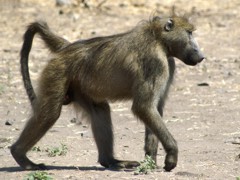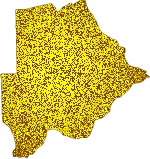Chacma Baboon - Papio ursinus
German: Pavian Bärenpavian; French: Le Babouin jeune; Spanish: Babuino (papion) negro
Italian: Babbuino nero; Polish: Pawian czakma; Setswana: Tswene
What is it?
A large, mostly terrestrial monkey.
Characteristics
Large and dog-faced, especially the males which are about twice the size of females. Grizzled greyish-brown pelage. Sloping back. Males have a mantle of long shoulder hair. The blackish muzzle is mostly hairless and resembles a dog’s, especially that of the male which is much elongated. The tail is angled upwards for the first third of its length and droops downwards for the remaining two thirds (“broken tail” or “riding whip” look); it is not prehensile. The thick bare skin of the rump below the tail (callosities) is undivided in males and separated in females.
The males have most impressive canines which can be longer than those of lions, though not as broad, and with these they can inflict severe wounds on each other during dominance fights.
Males 1.5 m in length, including tail and up to 43 kg in weight; females 1.1 m and up to 17 kg.
Newborn baboons have pink faces and black hair (this has changed to adult colouration by the sixth month). They are carried ventrally by the mother and from 6 – 12 weeks of age typically take up a “jockey” position on the mother’s lower back. Exceptionally, youngsters may ride on the backs of adult males.
Gestation 6 months; one young. No definite breeding season. The unsightly pinkish inflated sexual skin of adult females is connected to their oestrus cycle. This is attractive to large males which will consort and frequently mate with such females. Whilst the dominant male will have preferential mating opportunities with receptive females, the latter will also mate promiscuously and surreptitiously with other males.
Distribution: Can occur everywhere in the country, even close to or in the towns, where there is right habitat and enough food.


Status in Botswana: Common
Habitat: Can occur anywhere in Botswana given permanent water and trees or rocky kopjes in which to roost.
Best places to see: Throughout the Okavango region, Moremi Game Reserve, Chobe River, Tswapong Hills, Tuli, Kgale Hill. Often a nuisance at gates and campsite in the reserves and national parks.
Photo 1
Photo 2
Photo 3
Photo 3
Video clip
Diet
Omnivorous. Mostly eat soft grasses, seeds, bulbs, fruits and insects, but will opportunistically catch and eat birds, lizards and small mammals such as hares and the young of antelopes.
Longevity
Around 30 years.
Notes
Gregarious, living in troops numbering from a dozen or so to around 200. The typical size is 30 to 40 individuals. Home range areas may be from 2 to over 30m km² and vary according to the size of the troop and availability of food. Baboons are highly terrestrial but are agile climbers.
There is a dominant (or alpha) male who is at the head of the social hierarchy and who is periodically displaced by rivals, usually after aggressive encounters. All males outrank all females. Females have their own social hierarchy and inherit their rank from their mothers. Females do not emigrate from their natal troops as do the males at puberty.
These are amongst the most entertaining of animals and it is well worthwhile spending time observing their complex interactions. Some members of the troop will be quietly resting, some feeding, some engaged in mutual grooming (acting as social bonding), others chasing each other, whilst youngsters may often be seen swinging from branches or engaged in some mischievous activity.
In Moremi G.R.and Chobe N.P. baboons at sunset take to trees in which they roost during the night. They rise after sunrise and in cold weather may bask in the sun for a while before starting to forage for food. When active or at rest during the day one or more lookouts, often perched in trees above the troop, scan the area for predators which include leopards and lions. Baboons, unlike the majority of diurnal African wild mammal species, do not have feeding peaks in the early morning and late afternoon. A given troop may feed actively at any time of the day.
They are principally preyed upon by leopards and lions. Their other enemies are cheetahs, pythons and crocodiles.
Baboons are extremely keen-sighted. When on the move large males take the lead position. Low ranking females tend to be positioned on the perimeter of the troop. When danger threatens the adult males will rush to the defence of the troop and present a formidable appearance as they run towards a potential enemy barking; they can even sometimes chase off leopards.
Vocalisations include the loud bisyllabic bark of adult males and various grunts and screams.
Warning
Precautions for campers: if you are camping in Moremi or Chobe, you should be aware that baboons (and vervet monkeys) have become too familiar with people and their belongings and may raid your food stocks. They can unzip your tents, or rip them open to look for food. If you cannot leave someone to guard your tents and other belongings, then it is wise to collapse the tents and take your food with you when on game drives or pack it in lockable trunks. This is an inconvenience, but better than returning to camp to find tents destroyed and food missing. Even if you are in camp, watch the baboons and monkeys carefully: they are both very astute and adept at theft.
Some of the big males can even charge and try to bite or scratch you if they want to take something from you. They are very powerfull animals and could be very dangerous, and could inflict serious septic wounds. From time to time some of them have to be killed by wildlife officials if they become too dangerous to visitors. That is why it is so important not to feed any animals under any circumstances.
page and site still under construction
All rights reserved. Copy rights (design, images, text and graphics) by Marek Marciniak, Richard Randall - 2007